A Price-and-Branch Algorithm for Network Slice Optimization in Packet-Switched Xhaul Access Networks
Abstract
1. Introduction
- A network slicing-planning problem is addressed in the packet-switched Xhaul transport network with soft slice isolation and buffering latencies considered.
- The above problem is formulated as an optimization problem modeled using the MILP approach and assuming specific DU/CU placement and latency requirements of eMBB and URLLC network slices.
- The effective optimization method PBA based on the CG optimization technique is developed to facilitate solving the MILP problem for larger network instances.
- Extensive numerical experiments are performed, which show the advantages of the PBA and the performance of the packet-switched Xhaul network in different network slicing scenarios.
2. Related Works
3. Network Scenario
3.1. Packet-Switched Xhaul Access Network
3.2. Network Slicing
3.3. Traffic Model
3.4. Flow Prioritization
- SP–FH (same FH priorities), where all the FH flows are assigned the same (high) priority without respect for the network slice they belong to.
- DP–FH (different FH priorities), where the priorities of the FH flows are assigned according to the flow latency requirements. In particular, in this study, the URLLC FH flows have a higher priority than the eMBB FH flows.
3.5. Flow Latencies
4. Problem Formulation
- The DU processing for a cluster of RUs is performed at the same PP node.
- The CU processing for network slices realizing eMBB services is performed at the hub node.
- The CU processing for a network slice realizing URLLC services is performed at a selected PP node, where an MEC server is also colocated.
- The overall load related to DU and CU processing at a PP node cannot exceed the available PP capacity.
- The FH and MH flows are non-bifurcated and should be realized over single routing paths in the network.
- The overall volume (bit rate) of traffic in a network link cannot exceed the link capacity.
- The maximum one-way latency of an individual flow must not exceed the latency limit specific for this flow.
4.1. Notation
4.2. MILP Optimization Model
5. Optimization Method
5.1. Price-and-Branch Algorithm
- Generating initial solution: This step generates an initial solution necessary to initialize the set of paths in the column-generation procedure in Step (2). The solution is found using a greedy heuristic algorithm presented in Section 5.2.
- Generating paths: The goal of this step is to find a subset of the complete set of candidate paths that provides a good-quality solution to the problem and, at the same, decreases the computational effort of solving it. For this purpose, column generation (CG) is applied, which is an optimization technique allowing for a reduction of the number of variables (referred to as columns) in linear programming formulations [18,19]. The CG procedure dedicated to problem (2)–(24) is described in detail in Section 5.3.
- Solving MILP: In this last step, the set of candidate paths resulting from Step (2) is applied in MILP model (2)–(24), and the model is solved using a branch-and-bound solver (e.g., such as CPLEX v.12.9 [56]).
5.2. Generating Initial Solution
- Preprocessing: In the preprocessing phase, the clusters are ordered in decreasing order according to their number of demands. Also, the set of demands is ordered to reflect the order of clusters; i.e., the first demands correspond to those in the first clusters. Moreover, for each cluster, the PPs are ordered in increasing order according to the length of the shortest path to the most distant RU in the cluster. The following steps process the clusters, demands, and PPs according to such order.
- Placement of DUs with routing of FH flows: In this step, the consecutive clusters are processed, for which PP nodes are selected for the realization of DU functions according to a first-fit policy. Namely, the nearest feasible PP is chosen for each cluster , such that (a) it has enough capacity for DU processing for all demands in the cluster and (b) the FH flows can be realized with a latency and bandwidth guarantee over the shortest paths between the RUs belonging to the cluster and the PP selected.
- Routing of MH flows for eMBB demands: Here, the consecutive demands belonging to the network slices of type eMBB are processed. In particular, the shortest feasible routing paths, satisfying the latency and bandwidth constraints, are selected to realize MH flows between the previously chosen PPs (with DU processing) and the hub node, where the CU functions are performed for eMBB.
- Placement of CUs with routing of MH flows for URLLC demands: Finally, PP nodes for the CU processing are selected for URLLC network slices. Namely, for each slice , the PPs are ordered in decreasing order according to the overall DU load of the demands belonging to this slice. Next, the first feasible PP is chosen, such that (a) it can accommodate the CU load of the slice and (b) for which the MH flows can be realized in the network over the shortest paths with the latency and bandwidth guarantee.
5.3. Column-Generation Procedure
5.4. Algorithm Complexity
6. Numerical Results
6.1. Evaluation Scenario
6.2. Impact of Candidate Paths
6.3. Performance of PBA vs. MILP
6.4. Analysis of Network Performance
6.4.1. URLLC Traffic Ratio
6.4.2. PP Capacity
6.4.3. Network Slice Prioritization
6.4.4. Latencies
6.5. Illustration of Optimized Network Slicing in Urban Network
7. Applicability of PBA Optimization Method
8. Concluding Remarks
Funding
Institutional Review Board Statement
Informed Consent Statement
Data Availability Statement
Conflicts of Interest
References
- 3GPP. Study on New Radio Access Technology: Radio Access Architecture and Interfaces; Technical Report TR 38.801, v14.0.0; 3GPP: Sophia Antipolis, France, 2017. [Google Scholar]
- 3GPP. Architecture Description (Release 17); Technical Specification TS 38.401, v17.0.0; 3GPP: Sophia Antipolis, France, 2022. [Google Scholar]
- O-RAN Alliance. Available online: https://www.o-ran.org/ (accessed on 13 October 2023).
- Xiao, Y.; Zhang, J.; Ji, Y. Can Fine-grained Functional Split Benefit to the Converged Optical-Wireless Access Networks in 5G and Beyond? IEEE Trans. Netw. Serv. Manag. 2020, 17, 1774–1787. [Google Scholar] [CrossRef]
- Sirotkin, S. 5G Radio Access Network Architecture: The Dark Side of 5G; John Wiley & Sons: Hoboken, NJ, USA, 2020. [Google Scholar]
- I, C.L.; Li, H.; Korhonen, J.; Huang, J.; Han, L. RAN Revolution with NGFI (xhaul) for 5G. IEEE J. Lightw. Technol. 2018, 36, 541–550. [Google Scholar] [CrossRef]
- IEEE.1914.1-2019; IEEE Standard for Packet-based Fronthaul Transport Networks. IEEE: Piscataway, NJ, USA, 2019.
- IEEE.802.1CM-2018; IEEE Standard for Local and Metropolitan Area Networks—Time-Sensitive Networking for Fronthaul. IEEE: Piscataway, NJ, USA, 2018.
- Common Public Radio Interface: eCPRI V1.2 Interface Specification; Ericsson AB: Stockholm, Sweden; Huawei Technologies Co., Ltd.: Shenzhen, China; NEC Corporation: Tokyo, Japan; Nokia: Espoo, Finland, 2018.
- IEEE.1914.3-2018; IEEE Standard for Radio over Ethernet Encapsulations and Mappings. IEEE: Piscataway, NJ, USA, 2018.
- Larrabeiti, D.; Contreras, L.M.; Otero, G.; Hernandez, J.A.; Fernandez-Palacios, J.P. Toward end-to-end latency management of 5G network slicing and fronthaul traffic. Opt. Fib. Technol. 2023, 76, 103220. [Google Scholar] [CrossRef]
- ITU. Transport Network Support of IMT-2020/5G; ITU-T Technical Report; ITU: Geneva, Switzerland, 2018. [Google Scholar]
- The 3rd Generation Partnership Project (3GPP). Available online: http://www.3gpp.org/ (accessed on 13 October 2023).
- Ordonez-Lucena, J.; Ameigeiras, P.; Lopez, D.; Ramos-Munoz, J.J.; Lorca, J.; Folgueira, J. Network Slicing for 5G with SDN/NFV: Concepts, Architectures, and Challenges. IEEE Comm. Mag. 2017, 55, 80–87. [Google Scholar] [CrossRef]
- Bhattacharjee, S.; Katsalis, K.; Arouk, O.; Schmidt, R.; Wang, T.; An, W.; Bauschert, T.; Nikaein, N. Network Slicing for TSN-Based Transport Networks. IEEE Access 2021, 9, 62788–62809. [Google Scholar] [CrossRef]
- O-RAN Alliance. Xhaul Packet Switched Architectures and Solutions; Technical Specification v5.0; O-RAN Alliance: Alfter, Germany, 2023. [Google Scholar]
- Vassilaras, S.; Gkatzikis, L.; Liakopoulos, N.; Stiakogiannakis, I.N.; Qi, M.; Shi, L.; Liu, L.; Debbah, M.; Paschos, G.S. The Algorithmic Aspects of Network Slicing. IEEE Comm. Mag. 2017, 55, 112–119. [Google Scholar] [CrossRef]
- Pióro, M.; Medhi, D. Routing, Flow, and Capacity Design in Communication and Computer Networks; Morgan Kaufmann: Burlington, MA, USA, 2004. [Google Scholar]
- Desrosiers, J.; Lubbecke, M.E. Branch-Price-and-Cut Algorithms. In Wiley Encyclopedia of Operations Research and Management Science; John Wiley & Sons: Hoboken, NJ, USA, 2010. [Google Scholar]
- Klinkowski, M. Optimized Planning of DU/CU Placement and Flow Routing in 5G Packet Xhaul Networks. IEEE Trans. Netw. Serv. Manag. 2024, 21, 232–248. [Google Scholar] [CrossRef]
- Klinkowski, M. Optimization of Latency-Aware Flow Allocation in NGFI Networks. Comp. Commun. 2020, 161, 344–359. [Google Scholar] [CrossRef]
- Klinkowski, M. Latency-Aware DU/CU Placement in Convergent Packet-Based 5G Fronthaul Transport Networks. Appl. Sci. 2020, 10, 7429. [Google Scholar] [CrossRef]
- Carapellese, N.; Tornatore, M.; Pattavina, A.; Gosselin, S. BBU Placement over a WDM Aggregation Network Considering OTN and Overlay Fronthaul Transport. In Proceedings of the 2015 European Conference on Optical Communication (ECOC), Valencia, Spain, 7 September–1 October 2015. [Google Scholar]
- Musumeci, F.; Bellanzon, C.; Tornatore, N.C.M.; Pattavina, A.; Gosselin, S. Optimal BBU Placement for 5G C-RAN Deployment over WDM Aggregation Networks. IEEE J. Lightw. Technol. 2016, 34, 1963–1970. [Google Scholar] [CrossRef]
- Velasco, L.; Castro, A.; Asensio, A.; Ruiz, M.; Liu, G.; Qin, C.; Proietti, R.; Yoo, S.J.B. Meeting the Requirements to Deploy Cloud RAN Over Optical Networks. OSA/IEEE J. Opt. Commun. Netw. 2017, 9, B22–B32. [Google Scholar] [CrossRef]
- Wong, E.; Grigoreva, E.; Wosinska, L.; Machuca, C.M. Enhancing the Survivability and Power Savings of 5G Transport Networks based on DWDM Rings. OSA/IEEE J. Opt. Commun. Netw. 2017, 9, D74–D85. [Google Scholar] [CrossRef]
- Khorsandi, B.M.; Raffaelli, C. BBU location algorithms for survivable 5G C-RAN over WDM. Comput. Netw. 2018, 144, 53–63. [Google Scholar] [CrossRef]
- Carello, B.A.G.; Gao, M. On a Virtual Network Functions Placement and Routing Problem: Some Properties and a Comparison of Two Formulations. Networks 2020, 75, 158–182. [Google Scholar]
- Yu, H.; Musumeci, F.; Zhang, J.; Xiao, Y.; Tornatore, M.; Ji, Y. DU/CU Placement for C-RAN over Optical Metro-Aggregation Networks. In Proceedings of the 23rd IFIP WG 6.10 International Conference, (ONDM 2019), Athens, Greece, 13–16 May 2019. [Google Scholar]
- Xiao, Y.; Zhang, J.; Gao, Z.; Ji, Y. Service-Oriented DU-CU Placement using Reinforcement Learning in 5G/B5G Converged Wireless-Optical Networks. In Proceedings of the Optical Fiber Communication (OFC), San Diego, CA, USA, 8–12 March 2020. [Google Scholar]
- Wang, R.; Zhang, J.; Gu, Z.; Yan, S.; Xiao, Y.; Ji, Y. Edge-Enhanced Graph Neural Network for DU-CU Placement and Lightpath Provision in X-Haul Networks. OSA/IEEE J. Opt. Commun. Netw. 2022, 14, 828–839. [Google Scholar] [CrossRef]
- Edeagu, S.O.; Butt, R.A.; Idrus, S.M.; Gomes, N.J. Performance of PON Dynamic Bandwidth Allocation Algorithm for Meeting xHaul Transport Requirements. In Proceedings of the International Conference on Optical Network Design and Modeling, (ONDM 2021), Gothenburg, Sweden, 28 June–1 July 2021. [Google Scholar]
- Mondal, S.; Ruffini, M. A Min-Max Fair Resource Allocation Framework for Optical x-haul and DU/CU in Multi-tenant O-RANs. In Proceedings of the IEEE International Conference on Communications, Seoul, Republic of Korea, 16–20 May 2022. [Google Scholar]
- Liu, J.; Zhou, S.; Gong, J.; Niu, Z.; Xu, S. Graph-based Framework for Flexible Baseband Function Splitting and Placement in C-RAN. In Proceedings of the IEEE International Conference on Communications, London, UK, 8–12 June 2015. [Google Scholar]
- Koutsopoulos, I. Optimal Functional Split Selection and Scheduling Policies in 5G Radio Access Networks. In Proceedings of the IEEE International Conference on Communications (ICC 2017), Paris, France, 21–25 May 2017. [Google Scholar]
- Wang, X.; Alabbasi, A.; Cavdar, C. Interplay of Energy and Bandwidth Consumption in CRAN with Optimal Function Split. In Proceedings of the IEEE International Conference on Communications (ICC 2017), Paris, France, 21–25 May 2017. [Google Scholar]
- Alabbasi, A.; Wang, X.; Cavdar, C. Optimal Processing Allocation to Minimize Energy and Bandwidth Consumption in Hybrid CRAN. IEEE Trans. Green Commun. Netw. 2018, 2, 545–555. [Google Scholar] [CrossRef]
- Harutyunyan, D.; Riggio, R. Flex5G: Flexible Functional Split in 5G Networks. IEEE Trans. Netw. Serv. Manag. 2018, 15, 961–975. [Google Scholar] [CrossRef]
- Ejaz, W.; Sharma, S.K.; Saadat, S.; Naeem, M.; Anpalagan, A.; Chughtai, N.A. A Comprehensive survey on Resource Allocation for CRAN in 5G and Beyond Networks. J. Net. Comput. Appl. 2020, 160, 1–24. [Google Scholar] [CrossRef]
- Nakayama, Y.; Hisano, D.; Kubo, T.; Fukada, Y.; Terada, J.; Otaka, A. Low-Latency Routing Scheme for a Fronthaul Bridged Network. OSA/IEEE J. Opt. Commun. Netw. 2018, 10, 14–23. [Google Scholar] [CrossRef]
- Nakayama, Y.; Hisano, D. Rank-Based Low-Latency Scheduling for Maximum Fronthaul Accommodation in Bridged Network. IEEE Access 2018, 6, 78829–78838. [Google Scholar] [CrossRef]
- Garcia-Saavedra, A.; Salvat, J.X.; Li, X.; Costa-Perez, X. WizHaul: On the Centralization Degree of Cloud RAN Next Generation Fronthaul. IEEE Trans. Mob. Comput. 2018, 17, 2452–2466. [Google Scholar] [CrossRef]
- Mroziński, D.; Klinkowski, M.; Walkowiak, K. Cost-Aware DU Placement and Flow Routing in 5G Packet xHaul Networks. IEEE Access 2023, 11, 12710–12726. [Google Scholar] [CrossRef]
- Esmaeily, A.; Kralevska, K.; Mahmoodi, T. Slicing Scheduling for Supporting Critical Traffic in Beyond 5G. In Proceedings of the IEEE 19th Annual Consumer Communications & Networking Conference (CCNC), Las Vegas, NV, USA, 8–11 January 2022. [Google Scholar]
- Yusupov, J.; Ksentini, A.; Marchetto, G.; Sisto, R. Multi-Objective Function Splitting and Placement of Network Slices in 5G Mobile Networks. In Proceedings of the IEEE Conference on Standards for. Communications and Networking, Paris, France, 29–31 October 2018. [Google Scholar]
- Ojaghi, B.; Adelantado, F.; Antonopoulos, A.; Verikoukis, C. SlicedRAN: Service-Aware Network Slicing Framework for 5G Radio Access Networks. IEEE Syst. J. 2022, 16, 80–87. [Google Scholar] [CrossRef]
- Moayyedi, A. Generalizable GNN-based 5G RAN/MEC Slicing and Admission Control in Metropolitan Networks. In Proceedings of the IEEE/IFIP Network Operations and Management Symposium, Miami, FL, USA, 8–12 May 2023. [Google Scholar]
- Klinkowski, M. Analysis of Latency-Aware Network Slicing in 5G Packet xHaul Networks. Int. J. Electr. Telecomm. 2023, 69, 335–340. [Google Scholar] [CrossRef]
- Pramanik, S.; Ksentini, A.; Chiasserini, C.F. Characterizing the Computational and Memory Requirements of Virtual RANs. In Proceedings of the 17th Wireless On-Demand Network Systems and Services Conference (WONS), Oppdal, Norway, 30 March–1 April 2022. [Google Scholar]
- Imran, M.A.; Zaidi, S.A.R.; Shakir, M.Z. Access, Fronthaul and Backhaul Networks for 5G & Beyond; Institution of Engineering and Technology: London, UK, 2017. [Google Scholar]
- Esmaeily, A.; Mendis, H.V.K.; Mahmoodi, T.; Kralevska, K. Beyond 5G Resource Slicing With Mixed-Numerologies for Mission Critical URLLC and eMBB Coexistence. IEEE Open J. Comm. Soc. 2023, 4, 727–747. [Google Scholar] [CrossRef]
- Perez, G.O.; Larrabeiti, D.; Hernandez, J.A. 5G New Radio Fronthaul Network Design for eCPRI-IEEE 802.1CM and Extreme Latency Percentiles. IEEE Access 2019, 7, 82218–82229. [Google Scholar] [CrossRef]
- Lee, H.S.; Moon, S.; Kim, D.Y.; Lee, J.W. Packet-Based Fronthauling in 5G Networks: Network Slicing-Aware Packetization. IEEE Comm. Stand. Mag. 2023, 7, 56–63. [Google Scholar] [CrossRef]
- Common Public Radio Interface: eCPRI V1.2 Requirements for the eCPRI Transport Network; Ericsson AB: Stockholm, Sweden; Huawei Technologies Co., Ltd.: Shenzhen, China; NEC Corporation: Tokyo, Japan; Nokia: Espoo, Finland, 2018.
- Zhang, J.; Wang, T.; Finn, N. Bounded Latency Calculating Method, Using Network Calculus; IEEE 802.1 Working Group Interim Session; IEEE: Piscataway, NJ, USA, 2019. [Google Scholar]
- IBM. CPLEX Optimizer; IBM: New York, NY, USA, 2019. [Google Scholar]
- Lagen, S.; Giupponi, L.; Hansson, A.; Gelabert, X. Modulation Compression in Next Generation RAN: Air Interface and Fronthaul Trade-offs. IEEE Comm. Mag. 2021, 59, 89–95. [Google Scholar] [CrossRef]
- Shehata, M.; Elbanna, A.; Musumeci, F.; Tornatore, M. Multiplexing Gain and Processing Savings of 5G Radio-Access-Network Functional Splits. IEEE Trans. Green Commun. Netw. 2018, 2, 982–991. [Google Scholar] [CrossRef]
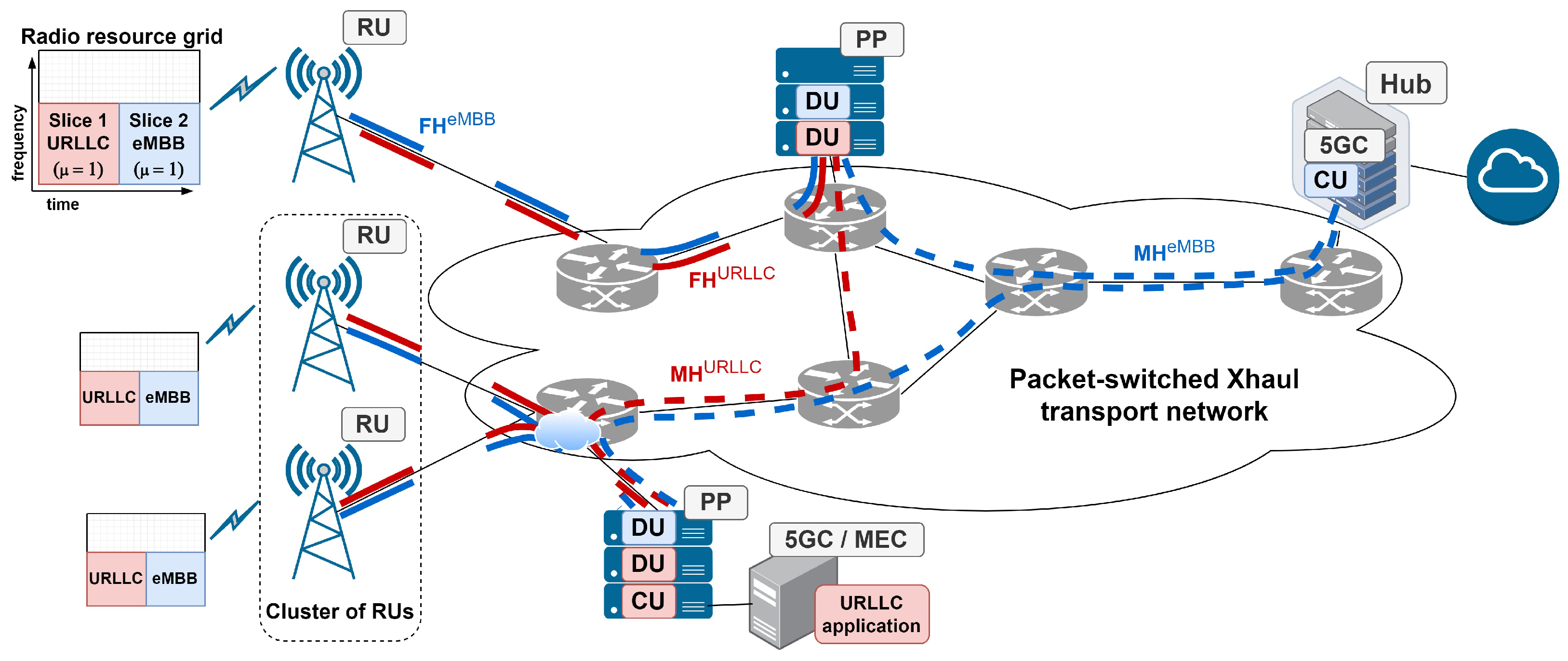


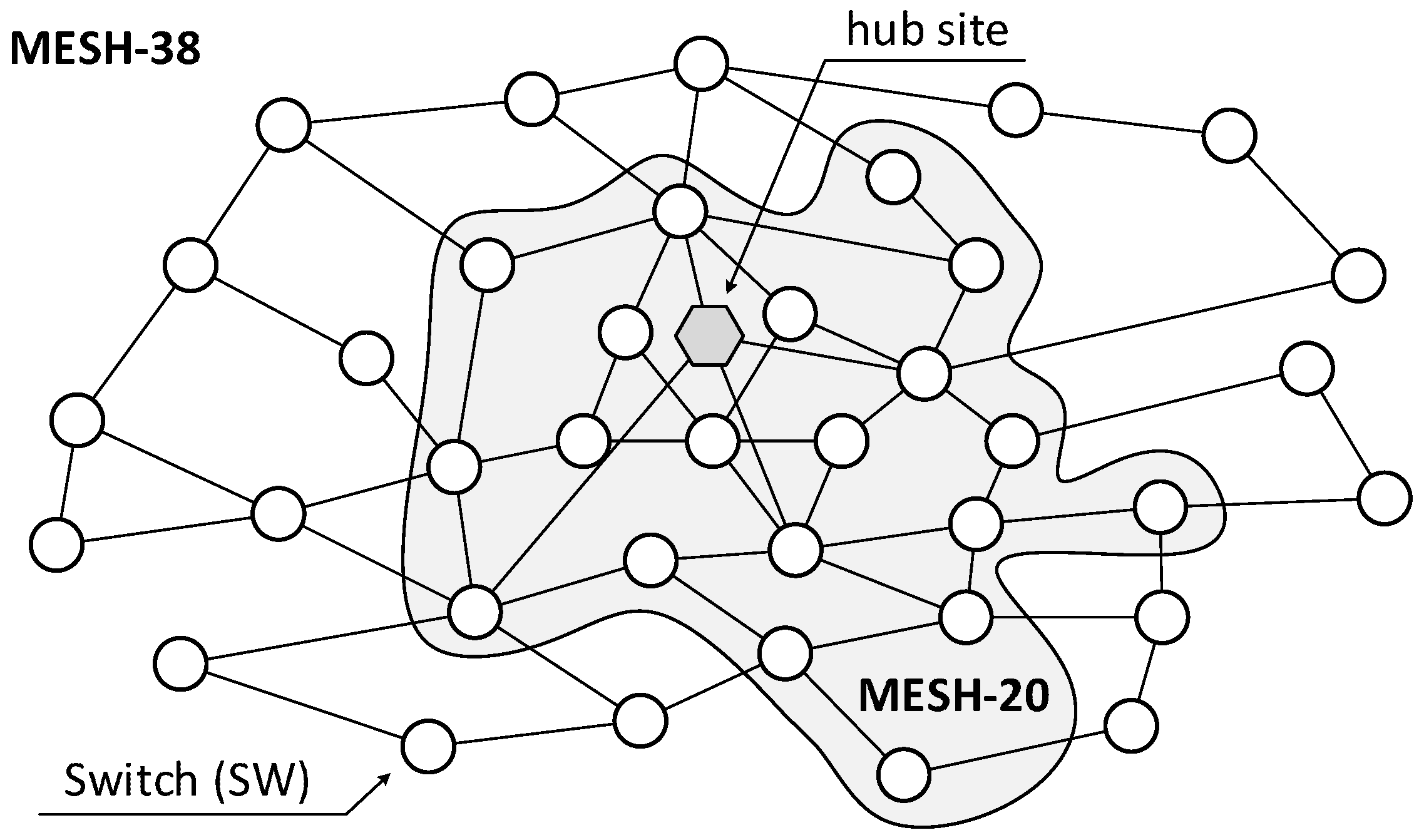
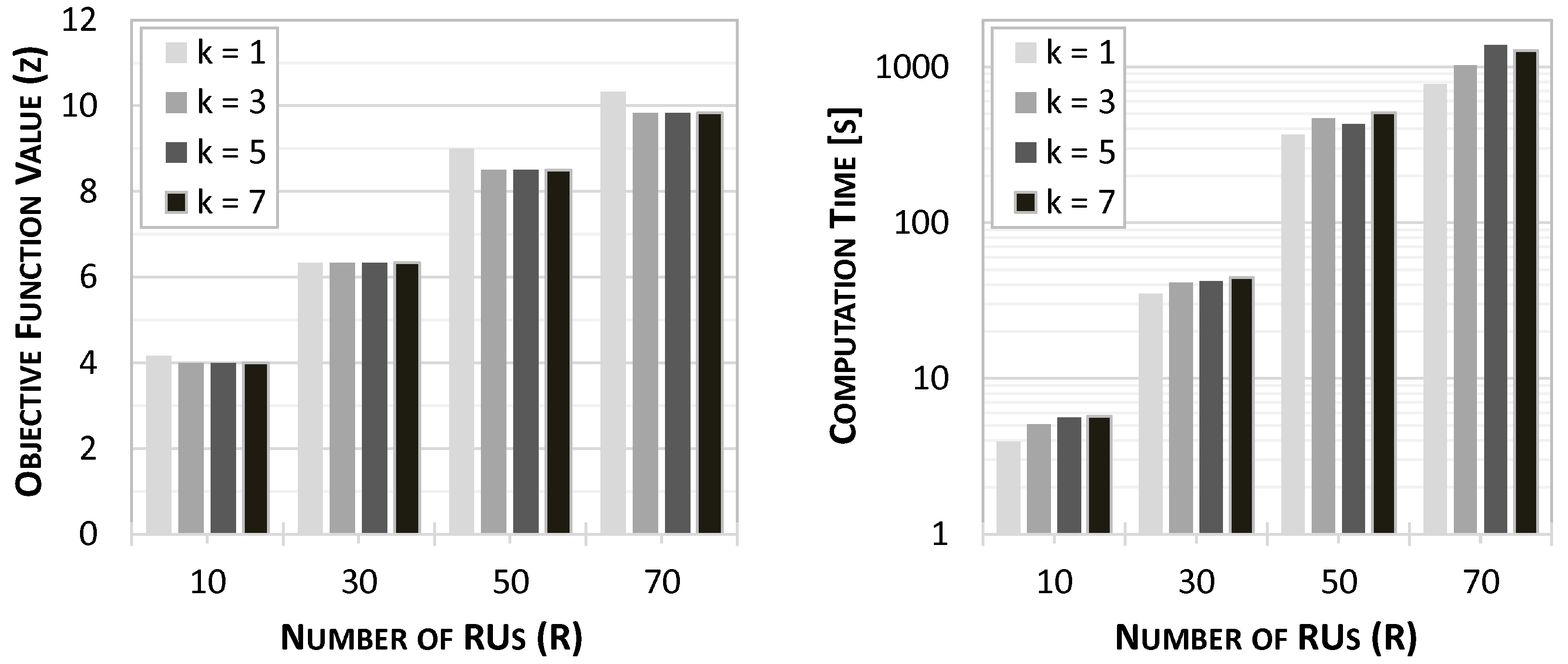

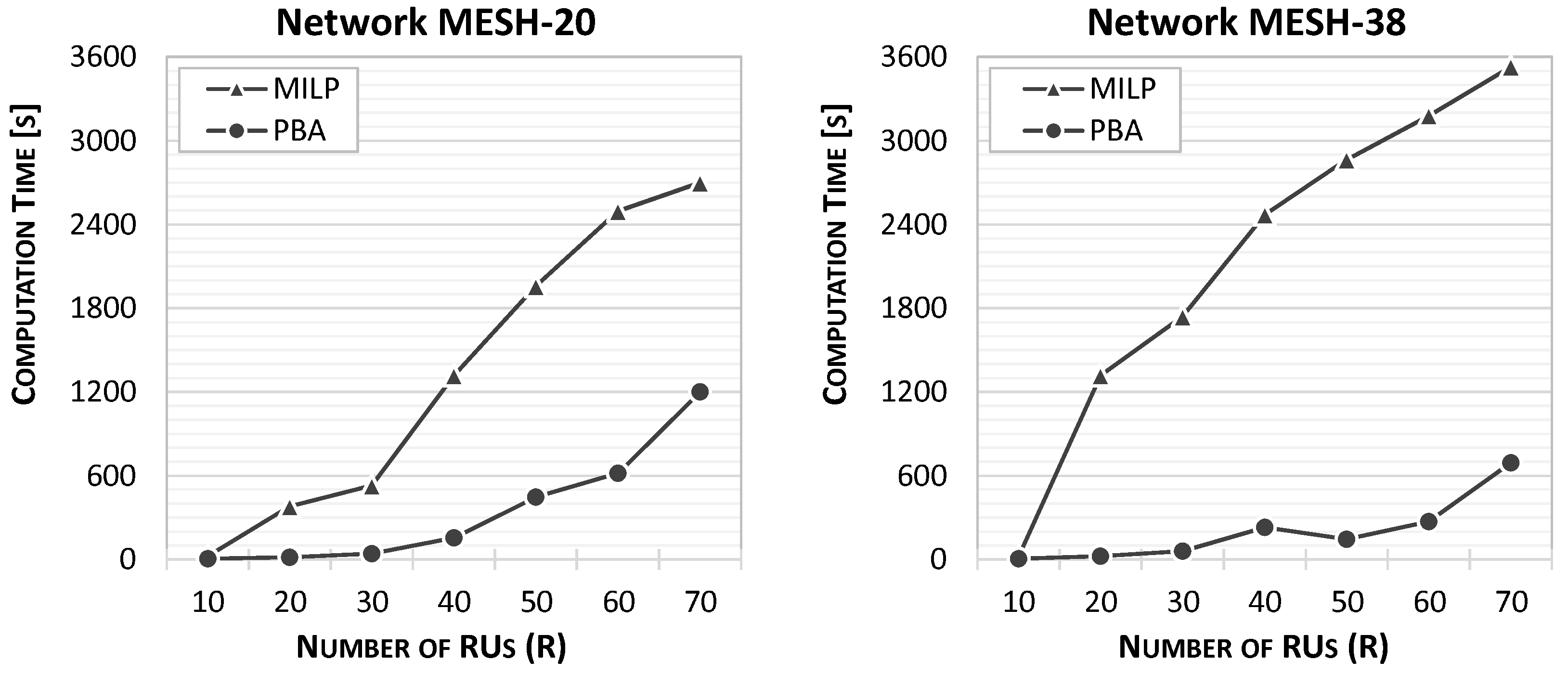
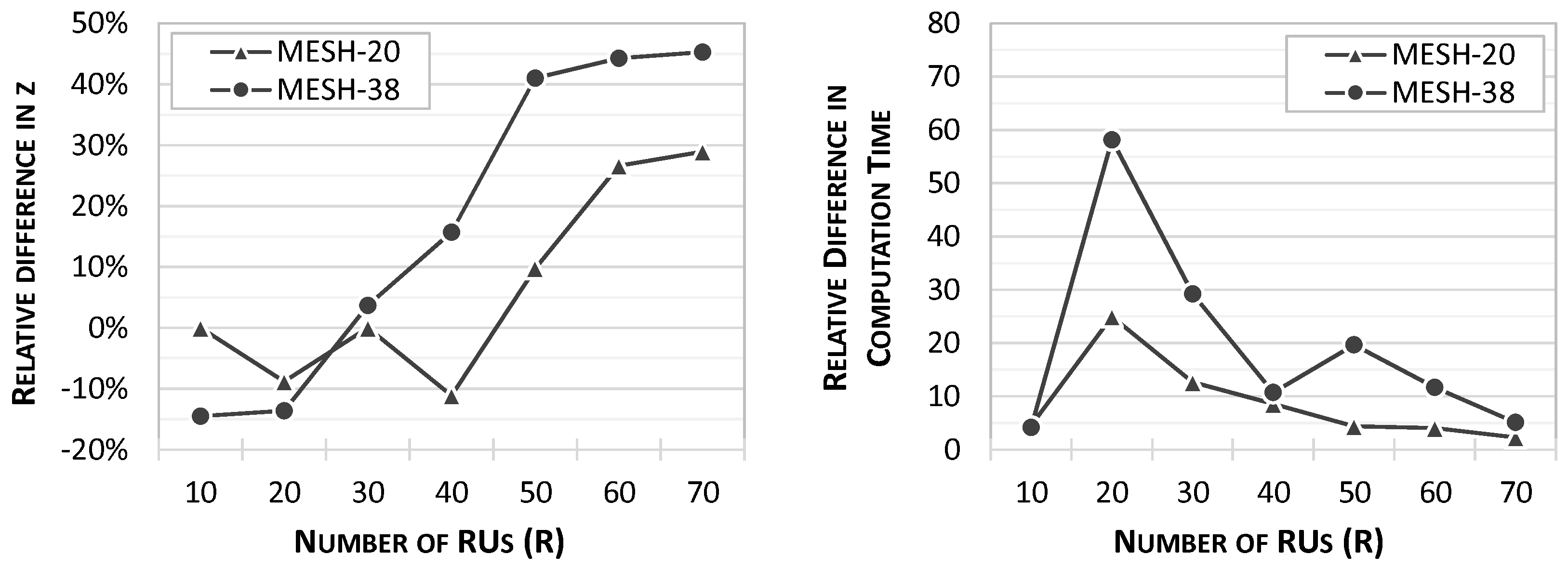
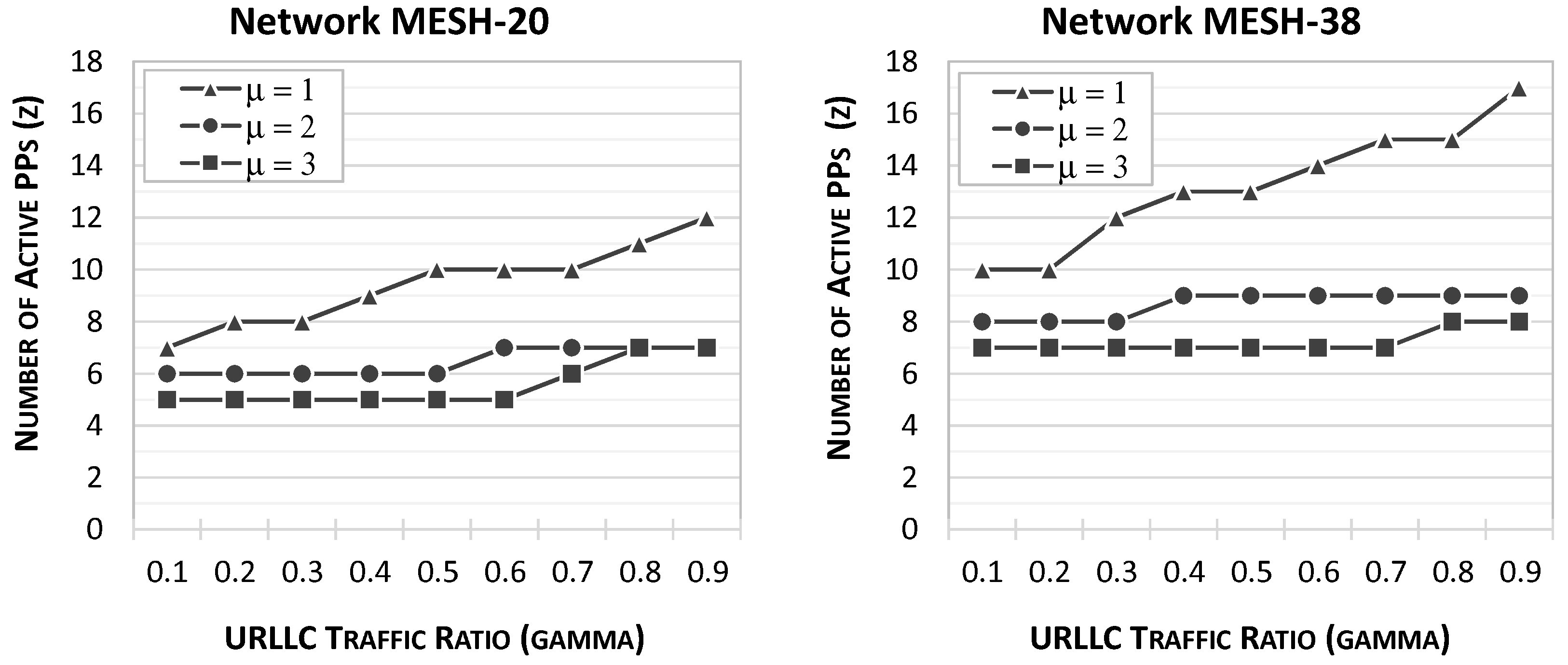
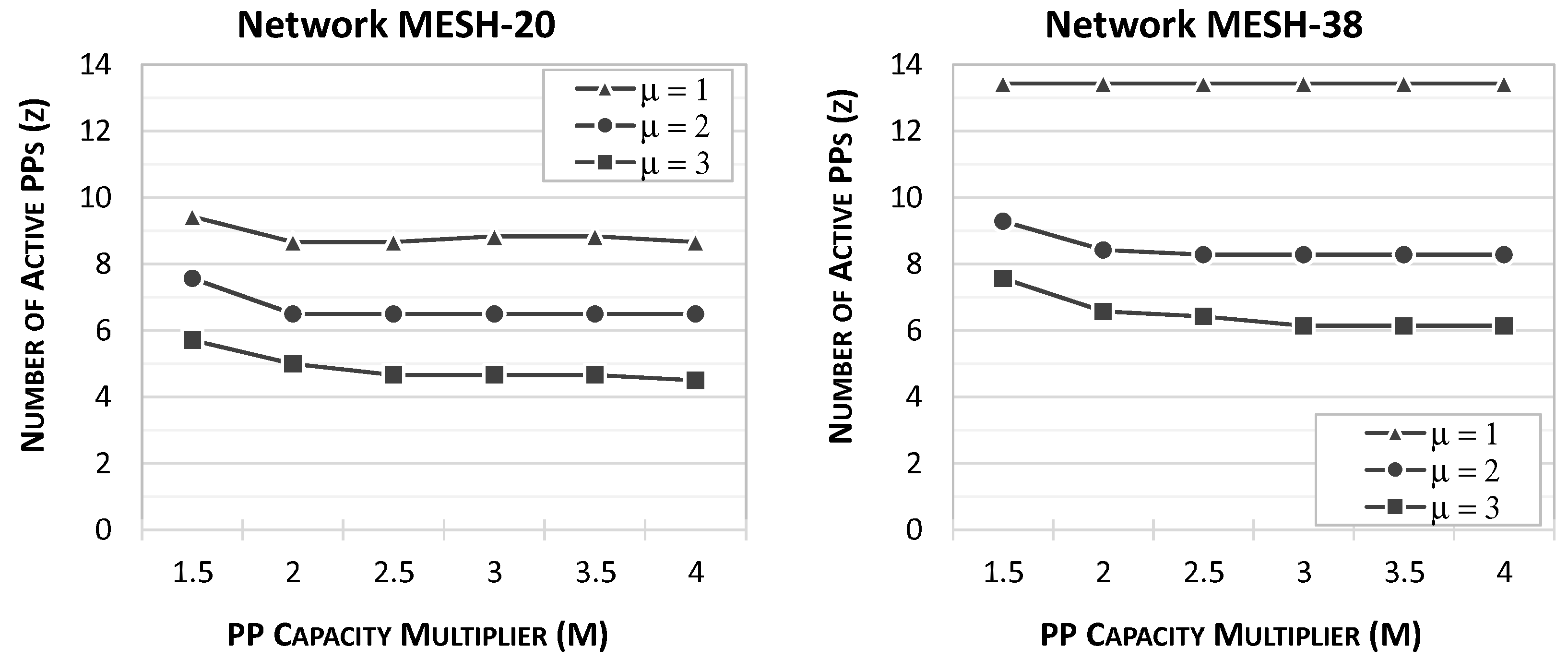

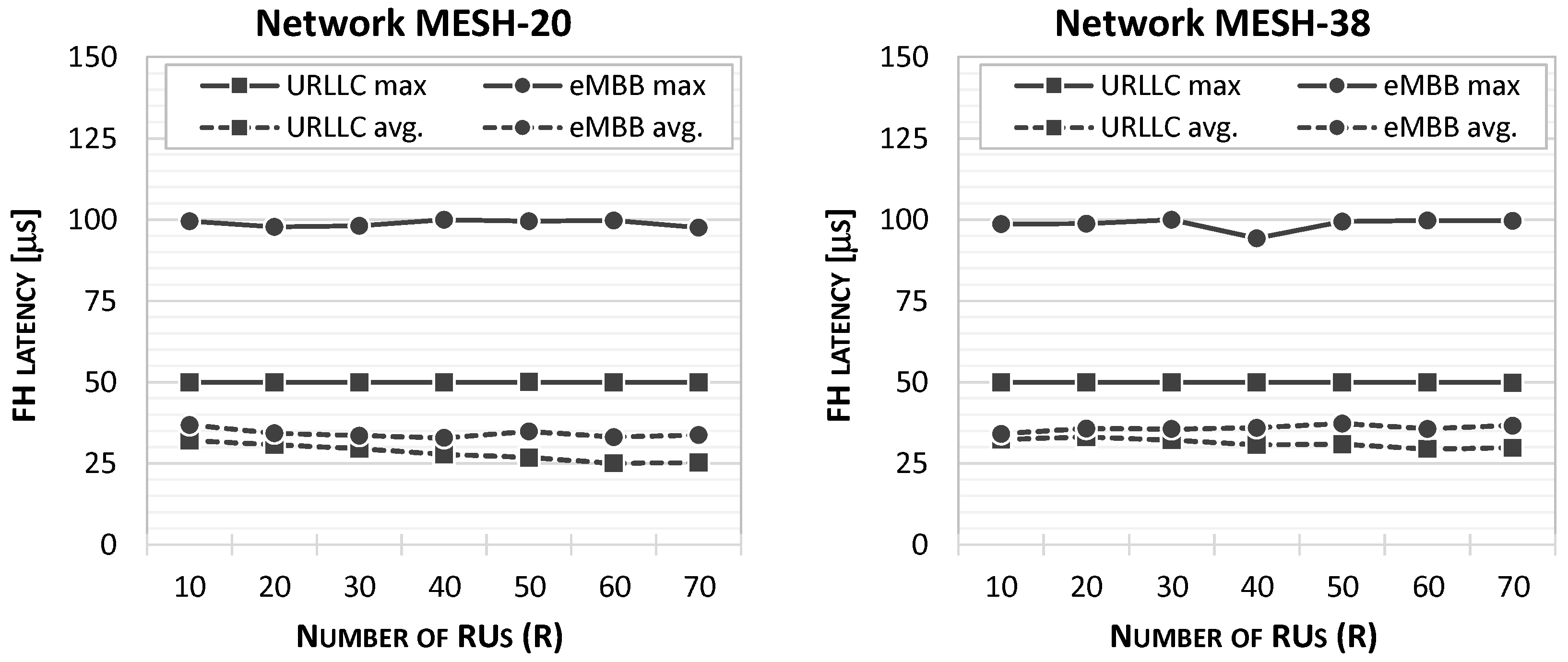
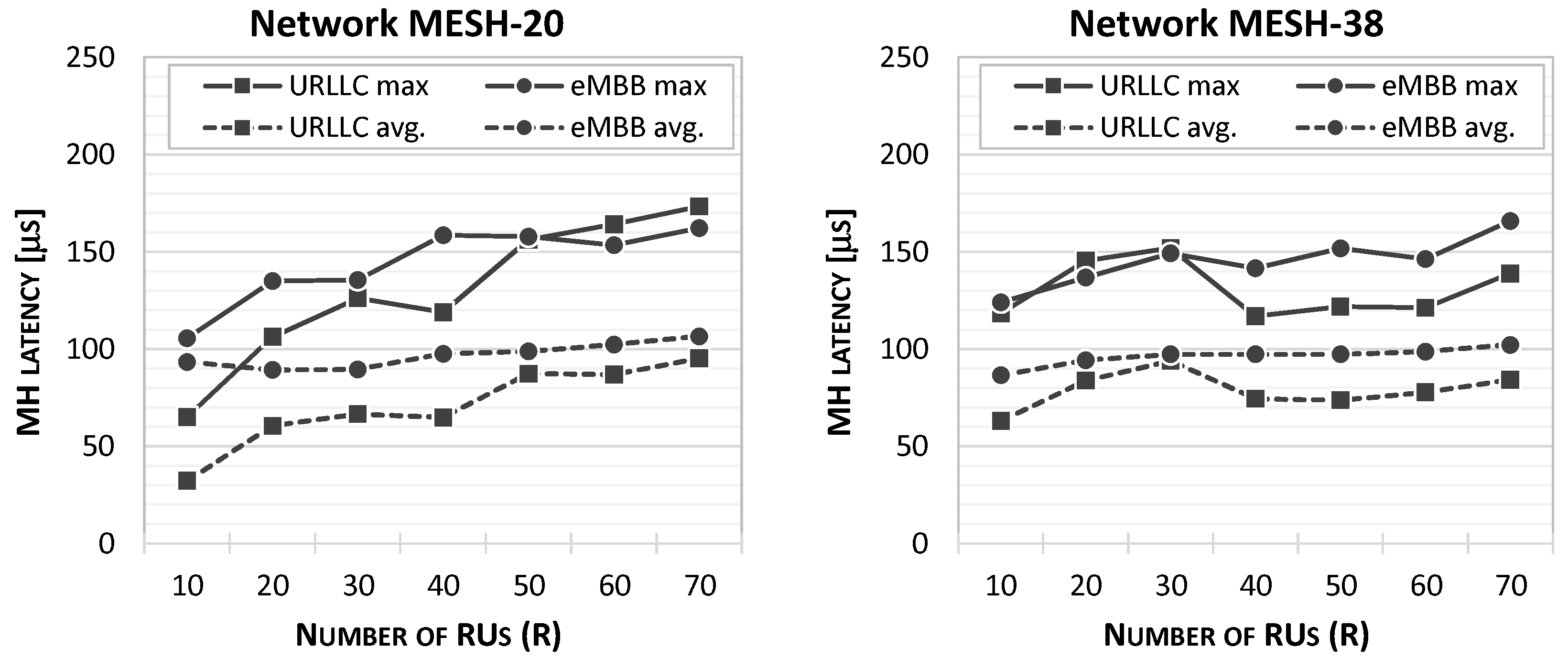

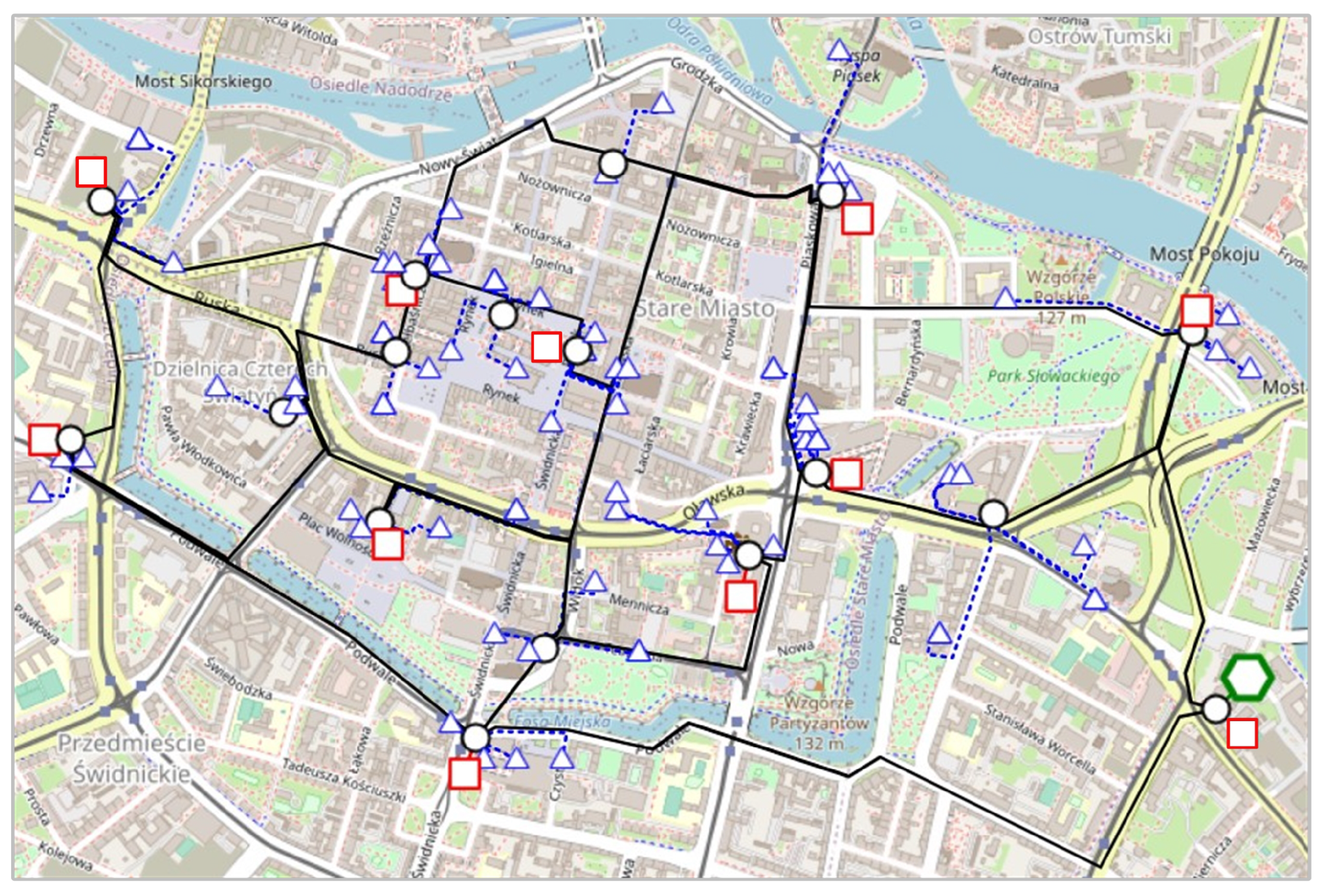
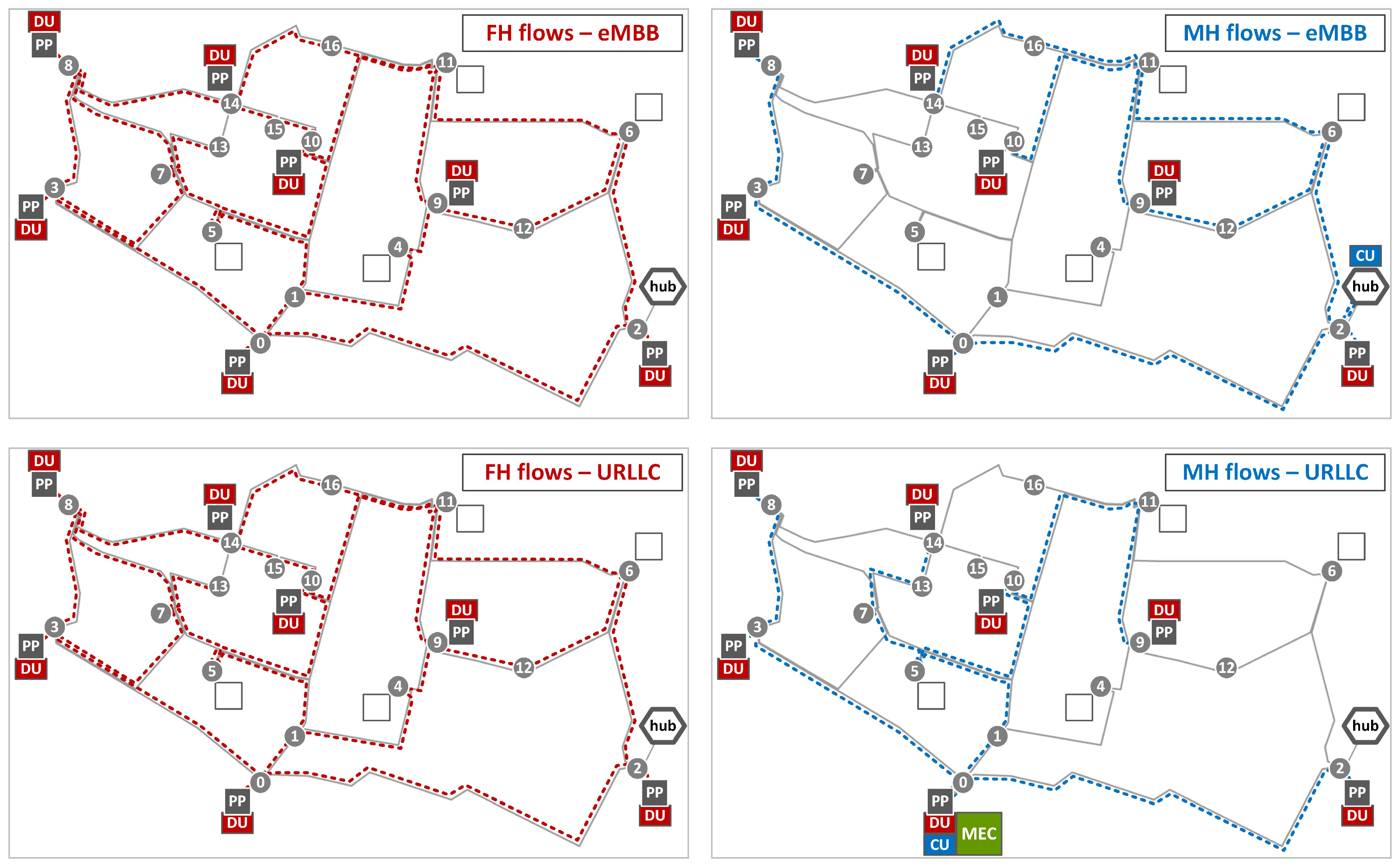
| Sets | |
| network nodes | |
| PP nodes; | |
| network links | |
| output links of switches; | |
| clusters of RUs | |
| types of network slices; | |
| network slices | |
| network slices of type eMBB; | |
| network slices of type URLLC; | |
| traffic demands | |
| demands associated with cluster ; | |
| demands belonging to network slice ; | |
| types of traffic flows; | |
| demand–flow pairs of an equal/higher priority than flow f of demand d, which cause buffering latencies of flow f in link | |
| demand–flow pairs of a lower priority than flow f of demand d, which cause buffering latencies of flow f in link | |
| possible values of latency produced by lower priority flows | |
| demand–flow pairs producing latency ; | |
| candidate routing paths | |
| candidate paths for flow f of demand d; | |
| candidate paths for flow f of demand d terminated at PP node v | |
| candidate paths for flow f of demand d going through link e | |
| links belonging to path p | |
| Parameters | |
| transmission capacity of link e | |
| processing capacity of PP node v | |
| bit rate of flow f of demand d | |
| processing load of the DU of demand d | |
| processing load of the CU of demand d | |
| propagation delay in link e | |
| store-and-forward delay of the switch being the origin of link | |
| delay produced by transmission of the burst of frames of flow f of demand d at link e | |
| overall latency of flows in set | |
| the value of latency | |
| maximum one-way latency limit of flow f of demand d | |
| binary, if cluster c has assigned PP node v for DU processing | |
| binary, if DU processing of demand d is performed in PP node v | |
| binary, if CU processing of demand d is performed in PP node v | |
| binary, if both CU and DU processing of demand d is performed in PP node v | |
| binary, if CU processing of URLLC slice s is performed in PP node v | |
| binary, if PP node v is active | |
| binary, if path p is selected to realize flow f of demand d | |
| binary, if flow f of demand d is routed over link e | |
| binary, if at least one of the LP flows belonging to is active | |
| continuous, latency of flow f belonging to demand d | |
| continuous, latency in link e for flow f of demand d caused by higher/equal-priority flows | |
| continuous, latency in link e for flow f of demand d caused by lower priority flows | |
| continuous, dynamic latency in link e for flow f belonging to demand d | |
| continuous, static latency in link e for flow f belonging to demand d |
| Objective | (2) | ||
| Constraints | |||
| placement of DU/CU | |||
| , | , | (3) | |
| , | , | (4) | |
| , | , | (5) | |
| , | , | (6) | |
| , | , | (7) | |
| , | , | (8) | |
| , | , | (9) | |
| path selection for flows | |||
| , | , | (10) | |
| , | , | (11) | |
| , | , | (12) | |
| , | , | (13) | |
| , | , | (14) | |
| usage of network links | |||
| , | , | (15) | |
| , | , | (16) | |
| latency of flows | |||
| , | (17) | ||
| , | , | (18) | |
| , | , | (19) | |
| , | , | (20) | |
| , | , | (21) | |
| , | , | (22) | |
| , | (23) | ||
| . | (24) | ||
| Flow | Uplink | Downlink |
|---|---|---|
| Fronthaul | 21.624 | 22.204 |
| Midhaul | 3.024 | 4.016 |
| Backhaul | 3 | 4 |
| Scenario | MILP | PBA | Relative Diff. | ||||||||||
|---|---|---|---|---|---|---|---|---|---|---|---|---|---|
| 1 | 10 | 40,200 | 4 | 0% | 4 | 1012 | 8 | 4 | 5 | 0.2 | 5 | 0% | 0.7 |
| 30 | 120,549 | 8 | 0% | 32 | 2959 | 14 | 8 | 34 | 2 | 36 | 0% | 0.9 | |
| 50 | 201,185 | 10 | 0% | 216 | 5844 | 18 | 10 | 236 | 19 | 255 | 0% | 0.8 | |
| 70 | 281,593 | 12 | 0% | 1110 | 9413 | 20 | 12 | 984 | 15 | 999 | 0% | 1.1 | |
| 2 | 10 | 40,752 | 4 | 0% | 23 | 1141 | 8 | 4 | 6 | 0.6 | 7 | 0% | 3.4 |
| 30 | 122,144 | 6 | 0% | 484 | 3136 | 14 | 6 | 31 | 3 | 34 | 0% | 14.4 | |
| 50 | 204,028 | 13 | 46% | 3600 | 6962 | 18 | 8 | 427 | 39 | 466 | 38% | 7.7 | |
| 70 | 285,518 | 16 | 63% | 3600 | 10,753 | 20 | 9 | 876 | 39 | 915 | 44% | 3.9 | |
| 3 | 10 | 41,190 | 4 | 0% | 71 | 1185 | 8 | 4 | 4 | 1 | 5 | 0% | 14.2 |
| 30 | 123,336 | 5 | 0% | 2022 | 3226 | 14 | 5 | 37 | 4 | 41 | 0% | 49.8 | |
| 50 | 206,012 | 14 | 63% | 3600 | 7291 | 18 | 7 | 507 | 107 | 614 | 50% | 5.9 | |
| 70 | 288,270 | 18 | 67% | 3600 | 11,792 | 20 | 8 | 1486 | 192 | 1678 | 56% | 2.1 | |
Disclaimer/Publisher’s Note: The statements, opinions and data contained in all publications are solely those of the individual author(s) and contributor(s) and not of MDPI and/or the editor(s). MDPI and/or the editor(s) disclaim responsibility for any injury to people or property resulting from any ideas, methods, instructions or products referred to in the content. |
© 2024 by the author. Licensee MDPI, Basel, Switzerland. This article is an open access article distributed under the terms and conditions of the Creative Commons Attribution (CC BY) license (https://creativecommons.org/licenses/by/4.0/).
Share and Cite
Klinkowski, M. A Price-and-Branch Algorithm for Network Slice Optimization in Packet-Switched Xhaul Access Networks. Appl. Sci. 2024, 14, 5608. https://doi.org/10.3390/app14135608
Klinkowski M. A Price-and-Branch Algorithm for Network Slice Optimization in Packet-Switched Xhaul Access Networks. Applied Sciences. 2024; 14(13):5608. https://doi.org/10.3390/app14135608
Chicago/Turabian StyleKlinkowski, Mirosław. 2024. "A Price-and-Branch Algorithm for Network Slice Optimization in Packet-Switched Xhaul Access Networks" Applied Sciences 14, no. 13: 5608. https://doi.org/10.3390/app14135608
APA StyleKlinkowski, M. (2024). A Price-and-Branch Algorithm for Network Slice Optimization in Packet-Switched Xhaul Access Networks. Applied Sciences, 14(13), 5608. https://doi.org/10.3390/app14135608






